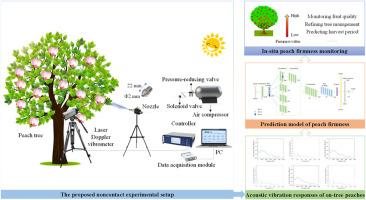Laser Doppler vibrometer enables in-situ monitoring of peach firmness
IF 4.4
1区 农林科学
Q1 AGRICULTURAL ENGINEERING
引用次数: 0
Abstract
Fruit firmness is a measure of the edible quality and maturity of peaches. In-situ monitoring of peach firmness can aid in fruit quality control and determining the optimal harvest time according to market demand. In this study, a non-contact acoustic vibration-based method was proposed for in-situ monitoring of fruit firmness of on-tree peaches. A new design of a compressed air excitation unit was constructed to impact the peach on the tree and a laser Doppler vibrometer was adopted to measure the acoustic vibration response (AVR) of the peach. To isolate the vibration information characterising fruit firmness, the AVR was firstly pre-processed by the wavelet threshold denoising method and then analysed by the autoregressive method to acquire the power spectral density (PSD) of the peach. For effectively extracting vibration features from the PSD to predict peach firmness, a novel one-dimensional convolutional neural network (CNNm) with multiscale perceptual fields was constructed. The performance of CNNm was compared with those of partial least squares regression, support vector regression models, and a single-branch 1D-CNN model with the mean absolute error (MAE), root mean square error (RMSE), coefficient of determination (R2), and residual prediction deviation (RPD). The results indicated that the proposed method enabled in-situ monitoring of peach firmness and the established CNNm model performed better than other models in predicting peach firmness ( = 0.813, MAEP = 1.636 N mm−1, RMSEP = 2.501 N mm−1, and = 2.334).

激光多普勒测振仪实现了对桃子硬度的现场监测
果实坚实度是衡量桃子可食用质量和成熟度的标准。对桃子果实坚实度的现场监测有助于果实质量控制和根据市场需求确定最佳采收时间。本研究提出了一种基于声学振动的非接触式方法,用于现场监测树上桃子的果实坚实度。研究人员建造了一个新设计的压缩空气激励装置来冲击树上的桃子,并采用激光多普勒测振仪来测量桃子的声学振动响应(AVR)。为了分离出表征果实坚硬程度的振动信息,首先用小波阈值去噪方法对声学振动响应进行预处理,然后用自回归方法对其进行分析,以获得桃子的功率谱密度(PSD)。为了有效地从 PSD 中提取振动特征来预测桃子的坚硬程度,我们构建了一个具有多尺度感知场的新型一维卷积神经网络(CNNm)。用平均绝对误差(MAE)、均方根误差(RMSE)、判定系数(R2)和残差预测偏差(RPD)比较了 CNNm 与偏最小二乘回归、支持向量回归模型和单分支一维卷积神经网络模型的性能。结果表明,所提出的方法可对桃子的坚实度进行现场监测,所建立的 CNNm 模型在预测桃子坚实度方面的表现优于其他模型(RP2 = 0.813、MAEP = 1.636 N mm-1、RMSEP = 2.501 N mm-1、RPDP = 2.334)。
本文章由计算机程序翻译,如有差异,请以英文原文为准。
求助全文
约1分钟内获得全文
求助全文
来源期刊

Biosystems Engineering
农林科学-农业工程
CiteScore
10.60
自引率
7.80%
发文量
239
审稿时长
53 days
期刊介绍:
Biosystems Engineering publishes research in engineering and the physical sciences that represent advances in understanding or modelling of the performance of biological systems for sustainable developments in land use and the environment, agriculture and amenity, bioproduction processes and the food chain. The subject matter of the journal reflects the wide range and interdisciplinary nature of research in engineering for biological systems.
 求助内容:
求助内容: 应助结果提醒方式:
应助结果提醒方式:


